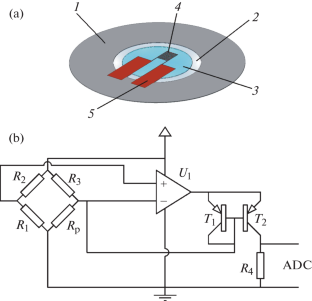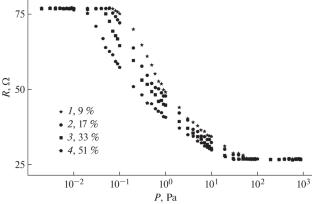基于多孔阳极氧化铝的低压热传感器
IF 0.8
Q3 Engineering
引用次数: 0
摘要
本文介绍了低压传感器的设计特点和成型技术,该传感器是一种沉积在铝箔上形成的多孔氧化铝膜表面的加热器。该结构采用廉价的低温方法完全形成。研究表明,通过增加加热元件和基体之间的膜区域的孔隙率,可以有效测量高达 2 × 10-2 Pa 的压力。本文章由计算机程序翻译,如有差异,请以英文原文为准。


Low-Pressure Thermal Sensor Based on Porous Anodic Aluminum Oxide
The paper presents the design features and technology of the formation of a low-pressure sensor, which is a heater deposited onto the surface of a porous aluminum-oxide membrane formed on aluminum foil. The structure is fully formed using inexpensive low temperature methods. It is shown that an increase in the porosity of the membrane region separating the heating element and the substrate makes it possible to effectively measure a pressure up to 2 × 10–2 Pa.
求助全文
通过发布文献求助,成功后即可免费获取论文全文。
去求助
来源期刊

Nanotechnologies in Russia
NANOSCIENCE & NANOTECHNOLOGY-
CiteScore
1.20
自引率
0.00%
发文量
0
期刊介绍:
Nanobiotechnology Reports publishes interdisciplinary research articles on fundamental aspects of the structure and properties of nanoscale objects and nanomaterials, polymeric and bioorganic molecules, and supramolecular and biohybrid complexes, as well as articles that discuss technologies for their preparation and processing, and practical implementation of products, devices, and nature-like systems based on them. The journal publishes original articles and reviews that meet the highest scientific quality standards in the following areas of science and technology studies: self-organizing structures and nanoassemblies; nanostructures, including nanotubes; functional and structural nanomaterials; polymeric, bioorganic, and hybrid nanomaterials; devices and products based on nanomaterials and nanotechnology; nanobiology and genetics, and omics technologies; nanobiomedicine and nanopharmaceutics; nanoelectronics and neuromorphic computing systems; neurocognitive systems and technologies; nanophotonics; natural science methods in a study of cultural heritage items; metrology, standardization, and monitoring in nanotechnology.
 求助内容:
求助内容: 应助结果提醒方式:
应助结果提醒方式:


